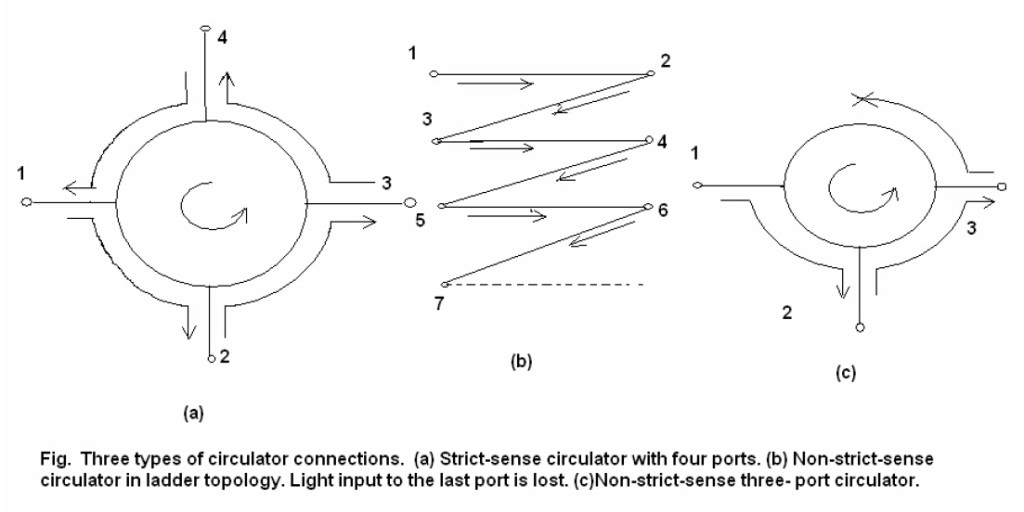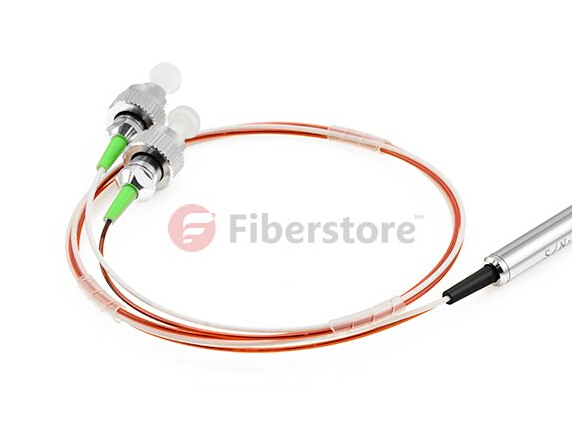An optical circulator is a generalized isolator having three or more ports. While an isolator causes loss in the isolation direction, a circulator collects the light and directs it to a non-reciprocal output port.

The figure drawn above shows the severa l possible circulator configurations.
Figure (a) illustrates the port mapping for a four-port circulator. The ports cyclically map 1 -> 2 -> 3 -> 4 -> 1. This is called a strict-sense circulator because every input port has a specific non- reciprocal output port. Construction of a strict-sense circulator with more ports becomes inelegant but ones with three ports becomes simple.
Figure (b) illustrates a non-strict-sense circulator having any number of ports greater than two. In this case each input port has a specific non-reciprocal output port except for the last port; the light input to the last port is lost. The ladder diagram reflects the optical path within the component and indicates the disconnect between the first and the last ports.
Figure (c) illustrates the three-port non-strict-sense circulator. This circulator has significance in telecommunication applications because return of light from port 3 to port 1 is not often required. For instance, the reflected light from a fibre Bragg grating need only be separated from the input light without loss, but as optical links are not typically operated in reverse there is no need for strict-sense behaviour.
An optical circulator allows the routing of light from one fibre to another based upon the direction of the light propagation. Nonreciprocal optical devices, such as optical isolators and optical circulators, are essential components of optical communication systems. Optical isolators pass light propagating in a forward direction while inhibiting the propagation of light in a backward direction. Since the optical circulator is an inherently non-reciprocal device, the light never goes to other ports. Optical circulators have wide applications. They are used to convert an existing unidirectional fibre optic communication link to a full duplex communication link by installing an optical circulator at each end of the link. Optical circulators are also used in fibre amplification systems, wavelength division multiplex (WDM) networks, optical time-domain reflectometers (OTDRs) and for test instruments.

Advantages
Although the optical sophistication of circulators makes them comparatively expensive, designers will appreciate the reliability and elegance imparted by fewer components. The resultant performance improvement may eliminate the need for more powerful transmitters, more sensitive receivers, and intermediate amplifiers, thus making optical circulators an economically interesting proposition. And, as with all technology, we can anticipate sharply lower prices as the optical circulator gains wider acceptance.
As one examines optical circulator applications, the notion of integrating the circulator, transmitter, and receiver into a single housing becomes very attractive. All elements would be aligned on a common platform, thus avoiding a multitude of external connectors and splices.
Where to Buy
Optical circulators is widely used in WDM networks, polarization mode dispersion, chromatic dispersion compensation, optical add-drop modules (OADM), optical amplifiers, OTDR and fibre sensing applications. Fiberstore offer 3/4 Ports Polarization-Insensitive optical circulator and 1310/1550/1064 Polarization-Maintaining (PM) optic circulators. Our fibre optical circulators can provide high isolation, very low insertion loss, low polarization dependent loss (PDL), low polarization mode dispersion (PMD), and excellent environmental stability. Any other wavelengths, without or with any connector can customised according to your requirement. Fiberstore also provide Cisco Optical Transceivers, such as Cisco GLC-SX-MMD, Cisco GLC-LH-SMD and Cisco GLC-T 1000base-T, etc.
